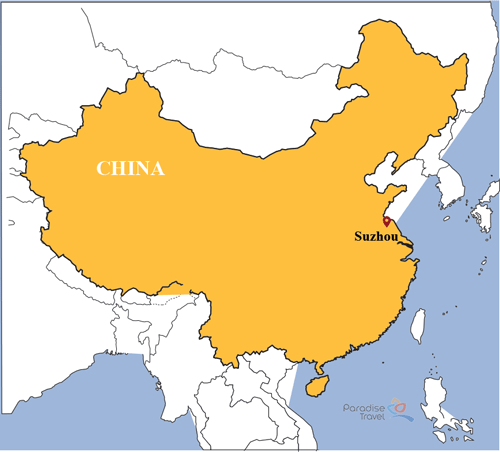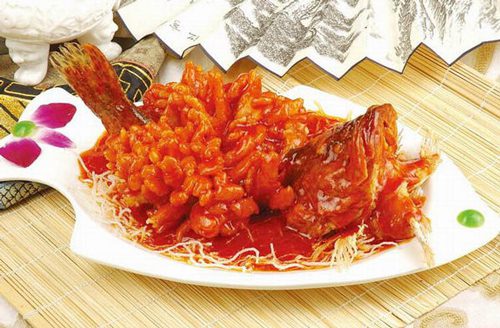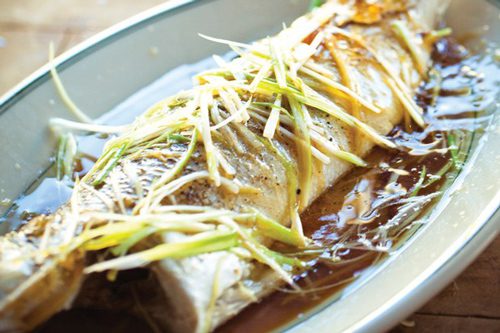Suzhou Travel Guide
 Suzhou, together with Hangzhou, are two most romantic cities in China. They are considered as ‘heaven on Earth’ by many Chinese poets, artists, and painters. Suzhou is located in southeastern China and it is about 100 kilometers from Shanghai. 42% of the city is covered by water with a vast system of dreamy ponds and streams. That’s the reason why it is called ‘Venice of China’.
Suzhou, together with Hangzhou, are two most romantic cities in China. They are considered as ‘heaven on Earth’ by many Chinese poets, artists, and painters. Suzhou is located in southeastern China and it is about 100 kilometers from Shanghai. 42% of the city is covered by water with a vast system of dreamy ponds and streams. That’s the reason why it is called ‘Venice of China’.
Found in 514 BC, this city has a long-lasting history which can be recognized from its traditional architecture and historic buildings. Suzhou’s rich culture, combined with its mild climate and great topography, make it the must-see destination for your China tour.
Best Time to Travel to Suzhou
We recommend you visit Suzhou in springs and autumns since the weather will be pleasant. This city experiences a high level of rainfall in May and June. Summers are hot here and the temperature can reach 38 degrees Celsius in July. Winters are cold and humid and it may snow in January.
Suzhou Travel Tips
- You can find four train stations in this city: Suzhou Station, Suzhou North Station (Bei Zhan), Suzhou Industrial Park Station (Yuanqu), and Suzhou New Area Station (Xinqu). Trains are highly developed here and you can travel to many cities including Beijing from Suzhou.
- It is advisable to avoid famous water towns and gardens during public holidays in China since these places will be crowded with local travelers.
- Suzhou is relatively safe, but be careful of pickpocketing at famous sightseeing spots.
What to See in Suzhou
1. Suzhou Museum

- Suzhou Museum
As a center of China’s trade, education, and recreation during imperial era, Suzhou is the place with many striking cultural highlights. Before visiting some classic gardens in Suzhou, let’s spend time in Suzhou Museum first to understand this town’s culture and history. Designed by a Chinese-American architect I.M.Pei, this museum is the combination of Suzhou’s traditional garden architecture and modern art in an area of over 10,000 square meters. This museum displays more than 30,000 historical and cultural relics including ancient paintings, porcelains, calligraphies, and other precious crafts made from jade and gold. Suzhou Museum is very close to Humble Administrator’s Garden and Lion Grove Garden.
2. Humble Administrator’s Garden

- Humble Administrator’s Garden
Built during Ming Dynasty (500 years old), Humble Administrator’s Garden is the largest classical garden in Suzhou. It is really gorgeous with lush trees, elegant pavilions, romantic ponds and winding paths. Humble Administrator’s Garden can be divided into three parts: Eastern Garden, Central Garden, and Western Garden. Eastern Garden is spacious with four main attractions: Orchid and Snow Hall (Lan Xue Tang), Pinery Lawn, Heavenly Spring Pavilion (Tianquan Pavilion) and the Cymbidium Goeingii Hall. The Central Garden is the most elite part of Humble Administrator’s Garden. One-third of its area is covered by water where you can take pictures of lotuses blooming in summers. Lastly, Western Garden is beautiful with many old buildings, hills, and ponds.
3. Lingering Garden

- Lingering Garden
Famous for its exquisite architectural art, Lingering Garden has a long history of over 400 years ago. Lingering Garden contains four main sections: Eastern Garden, Central Garden, Western Garden, and Northern Garden. The Central Garden is the most worth-visiting part since it is the most ancient section. With artificial mountains and lakeside scenery, Central Garden looks like an old Chinese painting. Lingering Garden is recognized as UNESCO Heritage site in 1997.
4. Master of the Nets Garden

- Master of the Nets Garden
Built during the Qing Dynasty (1636-1911), Master of the Nets Garden is the smallest garden in Suzhou – one-tenth the size of Humble Administrator’s Garden. Formerly, this garden belonged to an official under Song Dynasty (960-1279). Song Zongyuan, an official during Qing Dynasty, bought and restored this garden in 1765. This garden contains three parts: the residential section, the main garden and the inner garden. The main garden is pristine with ancient pavilions, intact pathways and rustic ponds.
5. Tongli Ancient Town

- Tongli Ancient Town
Built during Song Dynasty (over 1000 years ago), Tongli Ancient Town was originally called Futu (means ‘a prosperous land’ in English). It is 10 kilometers from the center of Suzhou and is one of the most popular ancient towns along Yangtze River’s bank, together with Nanxun, Wuzhen, Xitang, Zhouzhuang and Yongzhi. Tongli Ancient Town is praised as ‘the Oriental Venice’ due to its elegant architecture and rich culture. Ancient Bridges, Residential Houses and Tuisi Garden are interesting spots where you should take some photos. There are 55 ancient bridges in Tongli, which adds a rustic feature to this old town. The three most famous ones are Taiping Bridge, Jili Bridge and Changqing Bridge.
6. Zhouzhuang Water Town

- Zhouzhuang Water Town
30 kilometers from the Southeast of Suzhou, Zhouzhuang Water Town is a famous tourist attraction when traveling to Suzhou and Shanghai. Built in Ming and Qing Dynasty, currently this town still preserved more than 100 old houses with courtyards. Shen’s House, Zhang’s House and Ye Chucang’s Residence are where you can appreciate the elegance of Chinese classic architecture. Moreover, waterside lanes and the system of stone bridges have contributed to the beauty of Zhouzhuang Water Town. Twin Bridges, Fu’an Bridge, Zhenfeng Bridge and Fuhong Bridge are three most romantic bridges here. Taking a cruise along the town is the best way to appreciate its beauty.
What to Eat in Suzhou
Belonged to Jiangsu cuisine (also known as Su cuisine), one of the Eight Chinese Culinary Traditions, Suzhou is definitely a heaven for food connoisseurs. Suzhou foods tend to be sweet and the ingredients are carefully chosen according to the season. Taihu Lake supplies an abundant amount of fresh aquatic products to Suzhou. Fish is a common dish that you can find in every restaurant here. Suzhou cuisine is praised for its careful preparation, striking aroma, stunning color, and fresh taste.
1. Squirrel-shaped Mandarin fish (song shu gui yu)

- Squirrel-shaped Mandarin fish
Squirrel-shaped Mandarin fish is the local specialty of the scenic Suzhou. This dish is highly praised by domestic and foreign travelers for its beautiful color and fresh taste.
There are four things to notice when cooking Squirrel-shaped Mandarin fish. Firstly, the fish has to be carefully chosen to ensure that the dish can retain its tender. Secondly, the cutting technique needs to be excellent so that the fish’s shape resembles a squirrel. Thirdly, the fish is deep-fried so that its skin is crispy whilst the meat inside is soft and juicy. Fourthly, the amount of vinegar and sugar should be carefully mixed to make a delicious sweet-and-sour sauce.
2. Steamed Whitefish

- Steamed whitefish
There’s nothing more intriguing than enjoying seafood on a cruise along a water town. Steamed Whitefish is the signature Taihu Lake’s fish dish. Whitefish is carefully chosen and seasoned with ginger and pepper. Steaming retain the fish’s fresh flavor and aromatic smell.
3. Aozao Noodles

- Aozao Noodles
There are two kinds of Aozao Noodles in Suzhou: White Soup Noodles and Red Soup Noodles. The noodles are usually eaten with pork, duck, fish, eel or shrimps. The broth is made from meaty bones and many seasonings, which creates a beautiful color for the dish.
4. Whitebait Soup

- Whitebait Soup
Whitefish, white shrimps and whitebait are three treasures of Taihu Lake. Whitebait is the most delicious when enjoying in autumn. This soup contains rich broth and is eaten with ham, bamboo slices, some kinds of vegetables and whitebait’s liver.
5. Fried Shrimps with Biluo Tea

- Fried Shrimps with Biluo Tea
The fresh shrimps from Taihu Lake are seasoned with Biluo tea to create a unique taste and sophisticated fragrance. This food is decorated with some green tea leaves when being served to add elegance to the white shrimps.
Most famous restaurants in Suzhou
- Song He Lou (Pine and Crane Restaurant): No. 72, Taijian Nong, Pingjiang District
- De Yue Lou (Deyue Restaurant): There are two De Yue Lou restaurants in Taijian Nong. One is at No.43 and the other one is at No.8.
- Xie He Cai Guan (Xiehe Restaurant): No.15, Fenghuang Jie, Canglang District
- Shijia:18, Zhongshi Street, Mudu Town
- Wumen Renjia: 31, Panru Xiang, Pingjiang District
- Xiang Xue Hai (Donghuan Branch): No.930, Donghuan Lu, Suzhou Industrial Park
- Tongdexing Noodles Restaurant: 624, Shiquan Street, Canglang District
- Guanyu Chi: 133, Shizi Street, Canglang District
- Goodman Folk Snacks: 81, Bifeng Lane, Guanqian Street, Pingjiang District
- Haidilao Hot Pot: 7th Floor, Xinsutiandi Shopping Center, 219, Guangji South Road, Jinchang District











